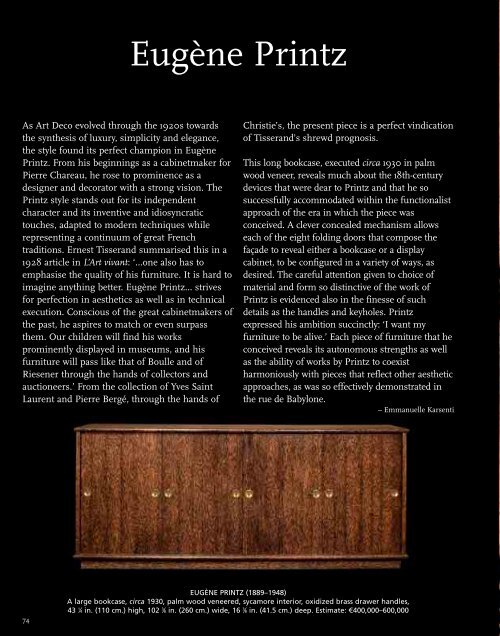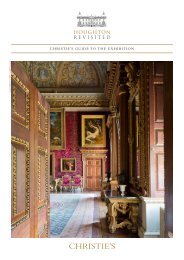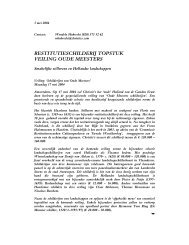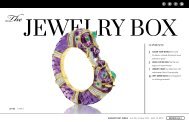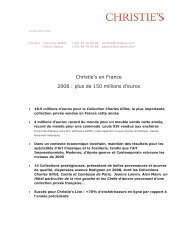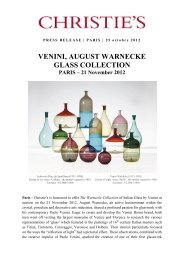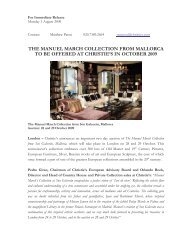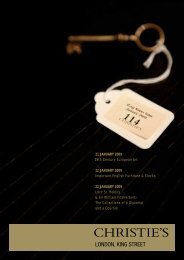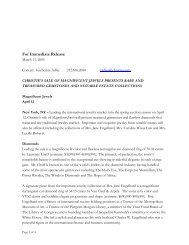Yves Saint Laurent Pierre Bergé - Christie's
Yves Saint Laurent Pierre Bergé - Christie's
Yves Saint Laurent Pierre Bergé - Christie's
Create successful ePaper yourself
Turn your PDF publications into a flip-book with our unique Google optimized e-Paper software.
As Art Deco evolved through the 1920s towards<br />
the synthesis of luxury, simplicity and elegance,<br />
the style found its perfect champion in Eugène<br />
Printz. From his beginnings as a cabinetmaker for<br />
<strong>Pierre</strong> Chareau, he rose to prominence as a<br />
designer and decorator with a strong vision. The<br />
Printz style stands out for its independent<br />
character and its inventive and idiosyncratic<br />
touches, adapted to modern techniques while<br />
representing a continuum of great French<br />
traditions. Ernest Tisserand summarised this in a<br />
1928 article in L’Art vivant: ‘…one also has to<br />
emphasise the quality of his furniture. It is hard to<br />
imagine anything better. Eugène Printz... strives<br />
for perfection in aesthetics as well as in technical<br />
execution. Conscious of the great cabinetmakers of<br />
the past, he aspires to match or even surpass<br />
them. Our children will find his works<br />
prominently displayed in museums, and his<br />
furniture will pass like that of Boulle and of<br />
Riesener through the hands of collectors and<br />
auctioneers.’ From the collection of <strong>Yves</strong> <strong>Saint</strong><br />
<strong>Laurent</strong> and <strong>Pierre</strong> <strong>Bergé</strong>, through the hands of<br />
74<br />
Eugène Printz<br />
Christie’s, the present piece is a perfect vindication<br />
of Tisserand’s shrewd prognosis.<br />
This long bookcase, executed circa 1930 in palm<br />
wood veneer, reveals much about the 18th-century<br />
devices that were dear to Printz and that he so<br />
successfully accommodated within the functionalist<br />
approach of the era in which the piece was<br />
conceived. A clever concealed mechanism allows<br />
each of the eight folding doors that compose the<br />
façade to reveal either a bookcase or a display<br />
cabinet, to be configured in a variety of ways, as<br />
desired. The careful attention given to choice of<br />
material and form so distinctive of the work of<br />
Printz is evidenced also in the finesse of such<br />
details as the handles and keyholes. Printz<br />
expressed his ambition succinctly: ‘I want my<br />
furniture to be alive.’ Each piece of furniture that he<br />
conceived reveals its autonomous strengths as well<br />
as the ability of works by Printz to coexist<br />
harmoniously with pieces that reflect other aesthetic<br />
approaches, as was so effectively demonstrated in<br />
the rue de Babylone.<br />
– Emmanuelle Karsenti<br />
EUGÈNE PRINTZ (1889–1948)<br />
A large bookcase, circa 1930, palm wood veneered, sycamore interior, oxidized brass drawer handles,<br />
43 1 ⁄4 in. (110 cm.) high, 102 3 ⁄8 in. (260 cm.) wide, 16 3 ⁄8 in. (41.5 cm.) deep. Estimate: 3400,000–600,000


